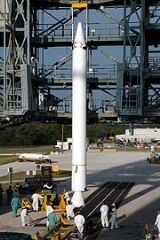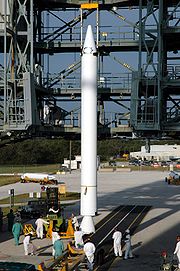
Booster rocket
Encyclopedia

Rocket
A rocket is a missile, spacecraft, aircraft or other vehicle which obtains thrust from a rocket engine. In all rockets, the exhaust is formed entirely from propellants carried within the rocket before use. Rocket engines work by action and reaction...
(or engine) is either the first stage of a multi-stage launch vehicle
Launch vehicle
In spaceflight, a launch vehicle or carrier rocket is a rocket used to carry a payload from the Earth's surface into outer space. A launch system includes the launch vehicle, the launch pad and other infrastructure....
, or else a strap-on rocket used to augment the core launch vehicle's takeoff thrust and payload capability. Boosters are generally necessary to launch spacecraft
Spacecraft
A spacecraft or spaceship is a craft or machine designed for spaceflight. Spacecraft are used for a variety of purposes, including communications, earth observation, meteorology, navigation, planetary exploration and transportation of humans and cargo....
into Earth orbit or beyond. In all cases, the booster is dropped into the ocean once its fuel is expended, a point known as booster engine cut-off (BECO). The rest of the launch vehicle continues flight with its core or upper stage engines. The booster may be recovered and reused, as in the case of the Space Shuttle
Space Shuttle
The Space Shuttle was a manned orbital rocket and spacecraft system operated by NASA on 135 missions from 1981 to 2011. The system combined rocket launch, orbital spacecraft, and re-entry spaceplane with modular add-ons...
.
Strap-on boosters are sometimes used to augment the payload or range capability of jet aircraft (usually military).
Drop-away engines
The Atlas rocketAtlas (rocket family)
Atlas is a family of U.S. space launch vehicles. The original Atlas missile was designed in the late 1950s and produced by the Convair Division of General Dynamics, to be used as an intercontinental ballistic missile...
used three engines, one of which was fixed to the fuel tank, and two of which were mounted on a skirt which dropped away at BECO. This was used as an Intercontinental ballistic missile
Intercontinental ballistic missile
An intercontinental ballistic missile is a ballistic missile with a long range typically designed for nuclear weapons delivery...
(ICBM); to launch the manned Project Mercury
Project Mercury
In January 1960 NASA awarded Western Electric Company a contract for the Mercury tracking network. The value of the contract was over $33 million. Also in January, McDonnell delivered the first production-type Mercury spacecraft, less than a year after award of the formal contract. On February 12,...
capsule into orbit; and as the first stage of the Atlas-Agena
Atlas-Agena
The Atlas-Agena was an American expendable launch system derived from the SM-65 Atlas missile. It was a member of the Atlas family of rockets, and was used for 119 orbital launches between 1960 and 1978....
and Atlas-Centaur
Atlas-Centaur
The Atlas-Centaur was an American expendable launch system designed and built by General Dynamics Convair Division in San Diego, CA. It was derived from the SM-65 Atlas missile. It was a member of the Atlas family of rockets, and was used for 61 orbital launches between 1962 and 1983. It was...
launch vehicles.
Strap-on boosters
The Titan IIITitan III
The Titan IIIC was a space booster used by the United States Air Force. It was launched from Cape Canaveral Air Force Station, FL., and Vandenberg Air Force Base, CA. It was planned to be used as a launch vehicle in the cancelled Dyna-Soar and Manned Orbiting Laboratory programs...
was developed from the Titan II
Titan II
The Titan II was an intercontinental ballistic missile and space launcher developed by the Glenn L. Martin Company from the earlier Titan I missile. Titan II was originally used as an ICBM...
launch vehicle by adding a pair of solid-fueled
Solid rocket
A solid rocket or a solid-fuel rocket is a rocket engine that uses solid propellants . The earliest rockets were solid-fuel rockets powered by gunpowder; they were used by the Chinese in warfare as early as the 13th century and later by the Mongols, Arabs, and Indians.All rockets used some form of...
strap-ons and used by the United States Air Force
United States Air Force
The United States Air Force is the aerial warfare service branch of the United States Armed Forces and one of the American uniformed services. Initially part of the United States Army, the USAF was formed as a separate branch of the military on September 18, 1947 under the National Security Act of...
as an unmanned heavy-lift vehicle. It was also planned to be used for the Manned Orbital Laboratory program, which was cancelled in 1969.
NASA
NASA
The National Aeronautics and Space Administration is the agency of the United States government that is responsible for the nation's civilian space program and for aeronautics and aerospace research...
's Space Shuttle
Space Shuttle
The Space Shuttle was a manned orbital rocket and spacecraft system operated by NASA on 135 missions from 1981 to 2011. The system combined rocket launch, orbital spacecraft, and re-entry spaceplane with modular add-ons...
was the first manned vehicle to use solid-fueled boosters as strap-ons. The solid boosters consisted of stacked segments, and were recovered and reused multiple times.
Use in aviation
Rocket boosters used on aircraft are known as Jet-Assisted TakeOff (JATO)JATO
JATO is an acronym for jet-fuel assisted take off. It is a system for helping overloaded aircraft into the air by providing additional thrust in the form of small rockets....
rockets.
Various missile
Missile
Though a missile may be any thrown or launched object, it colloquially almost always refers to a self-propelled guided weapon system.-Etymology:The word missile comes from the Latin verb mittere, meaning "to send"...
s also use solid rocket boosters. Examples are;
- 2K11 (SA-4) which uses SRBs as a first stage, and then a ramjetRamjetA ramjet, sometimes referred to as a stovepipe jet, or an athodyd, is a form of airbreathing jet engine using the engine's forward motion to compress incoming air, without a rotary compressor. Ramjets cannot produce thrust at zero airspeed and thus cannot move an aircraft from a standstill...
. - S-200 (SA-5) which uses SRBs as the first stage, followed by a solid fuel rocket.
- Surface launched versions of the turbojet powered Boeing HarpoonBoeing HarpoonThe Harpoon is an all-weather, over-the-horizon, anti-ship missile system, developed and manufactured by McDonnell Douglas . In 2004, Boeing delivered the 7,000th Harpoon unit since the weapon's introduction in 1977...
use an SRB.
Other uses
Another use of the term "booster" in spaceflight is the Booster Systems Engineer, whose call sign is Booster. This is a support position at NASANASA
The National Aeronautics and Space Administration is the agency of the United States government that is responsible for the nation's civilian space program and for aeronautics and aerospace research...
's Mission Control Center
Mission Control Center
A mission control center is an entity that manages aerospace vehicle flights, usually from the point of lift-off until the landing or the end of the mission. A staff of flight controllers and other support personnel monitor all aspects of the mission using telemetry, and send commands to the...
.

